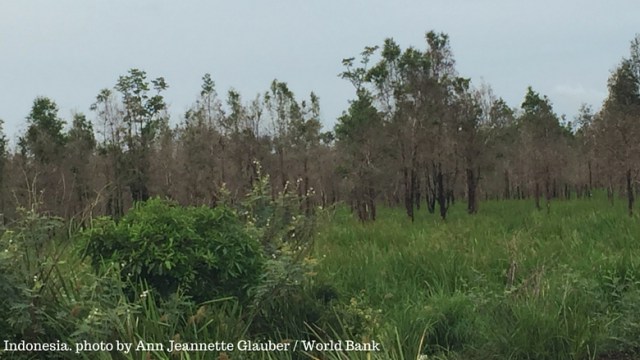Plantations International Information
By Ann Jeannette Glauber. At first published at The Globe Financial organization.
This previous autumn, I saw a stunning going: Woodland fires in Indonesia were creating as great deals of greenhouse gas tires as the whole U.S.A economy.Between June as well as October 2015, an approximated 2.6 million hectares– – or 4.5 times the dimension of Bali– – shed to clear land for production of hand oil, the world’s biggest worth non-timber woodland plant, utilized in food products, cosmetics, biofuels.Recently, in enhancement to Vice President for Lasting Improvement Laura Tuck as well as Indonesia Nation Director Rodrigo Chaves, I took a look at South Sumatra, among the districts hardest struck by the fires.We saw scrubby fire-adapted landscapes that had actually altered biodiversity-rich peat overload forests.We spoke with neighborhood communities that discussed how they covered windows and doors with wet towels, to aid decrease the smoke. These families are amongst the half million people that dealt with fire-related breathing infections, skin in addition to eye conditions; their kids were among the 4.6 million students who missed establishment last year as a result of fires, some for weeks at a time.While some of these households lost revenues or residential properties as a result of the fires, others discussed how fire improves filth quality.Indeed, the fires are not without beneficiaries– – but they are fairly few. Required for hand oil is high. Fifty percent of worldwide hand oil production is in Indonesia, 75 percent for exports.Clearing of peatlands promises quick returns:$ 3000 each hectare after 3 years after growing oil hand. At this rate, last year’s fires would definitely generate$ 8 billion. However the areas staying in as well as around timberlands, where destitution rates can be dual the nationwide standard, see couple of benefits.Production on peatlands contributes much less compared to 1 % to Indonesia’s economic environment. Nevertheless weak enforcement of existing constraints to suppress peatlands growth has really caused proceeded burning. Peatland fires last longer, are a lot more hard to produce, as well as send a great deal even more emissions as compared to fires on numerous other dirt types.A Globe Financial organization analysis, located that fires throughout even more compared to 10,000 square miles establish you back Indonesia$ 16.1 billion in 2015, equivalent to 1.9 % of GDP. This$ 16 billion is higher than the worth of hand oil production in Indonesia in 2014, as well as enhance the rate of reconstructing Aceh area after the 2004 tsunami.At one location along South Sumatra’s Musa River, we saw the difficulties of lasting land management in Indonesia’s bogs: a nationwide woodland fifty percent of which shed last year, plenty of hectares of oil hand and pulp wineries, and a new pulp mill– – virtually completed – that will be the globe’s largest.Many have required a total fire restriction. Their debate is uncomplicated. Existing regulations allow burning by farmers with much less than 2 hectares of land, and such fires can broaden of control, or be condemned as the reason for fires established much less scrupulously.Where does that leave the smallholders, that state fires are the most cost effective kind of land clearing? Is there a much less harmful way to maintain smallholder farmers? Such a method could possibly include fire restrictions at specific times and in particular areas, in addition to alternate land clearing up approaches as well as restraints on cleaning in susceptible
areas.This support for smallholders can be matched by the Government’s actions to recover innovation of peatlands– – a vital action in the excellent instructions. Additional activity must be simply as vital: boost fire administration; strengthen land details with the One Map effort; and look after along with restore Indonesia’s peatlands and
lowland landscapes.Why focus ablaze? Due to that Indonesia’s fire administration is currently focused on reductions, likewise though researches show that $ 1 bought fire avoidance saves$ 30 in reductions. Investments ought to concentrate on dangers from climate condition, gas (such as peat or woody particles)or social problems, which call for enhancements in surveillance as well as comments systems, as well as instating mechanisms that rapidly supply and also supply devices in addition to resources. In South Sumatra, some fire hoses gotten to just a few hundred meters. This is not sufficient.The next priority is to generate One Map, which would certainly put together land information across Indonesia into a solitary home window.
Without clear acknowledged boundaries as well as a solitary computer system registry for public lands, land as well as fire administration is impossible. One Map would likewise help resolve land duration instability, a vital factor to land degradation and fires.Requiring information compilation from numerous firms, arrangements on information sharing, and also info acknowledgment, developing One Map will absolutely be testing. Inter-agency control– – up until currently incredibly elusive in Indonesia– – will absolutely be vital.The 3rd immediate activity issues safeguarding peatlands, as well as the brand-new Peatland Remediation Business is motivating. Yet recovering 2 million hectares of peatlands in 5 years will definitely call for strong help from the Ministry of Public Functions as well as various other equivalents. In the previous, lowland growth has been uncoordinated. Can Indonesia simultaneously give multiplied development in some lowland locations, while boosting water as well as land administration in peatland locations and also securing the continuing to be undamaged peat overload forests?Landscape management is durable, pricey, as well as eager.
Success calls for building restoration, including, amongst others, assigning institutional authority and also role-sharing arrangements, recognizing top priority”deep peat” areas and reclassification of land-use along with zoning. Funding as well as budgetary mechanisms for the many efforts must similarly be secured.Can and will these financial investments be made? Can Indonesia construct successful economic environments in the bogs while simultaneously shielding its natural down payments? Plantations International
The post Seeing the impact of woodland fires in South Sumatra: a perspective from the location showed up initially on Plantations International.
